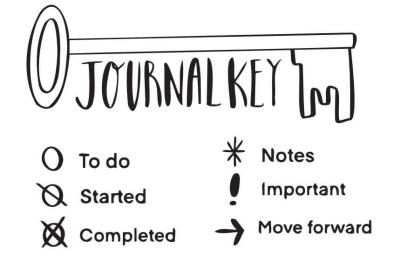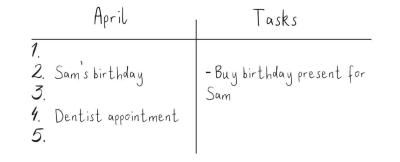Bullet journal ideas
If you’ve never tried bullet journaling before, now might be a great time to start! Read on for bullet journal ideas, tips and templates to help you get started.
What is a bullet journal?
Bullet journaling is a system to help you track, organise and plan your life.
The bullet journal system was created by New York based designer, Ryder Carroll. He describes bullet journals as a way “to help you track the past, organize the present, and plan for the future.”
How do I get started?
You’ll need:
- A journal with dotted pages (ideally)
- Pencil
- Fine line pen (Micron pens are great)
- Highlighter pens
- Washi tape and stickers
- Scissors
- Glue
- Ruler
If you want to get more creative: Explore using watercolours, gouache, POSCA markers… Anything you fancy really. Make sure the paper in your journal is thick enough to use with paints. You may need a paintbrush (if you want to get painty with it).
Journal page ideas
You can use your journal as a planner, but you can also use it to jot down ideas, thoughts, feelings, memories… anything you want. Getting your thoughts down on paper can help to clear your mind or get ideas flowing.
Here are some page ideas to get you started:
Gratitude or Best moments this year
Write down the things you’re thankful for in your life. Write down your happy moments and special memories. It doesn’t matter how small these things are. If you do this every day you can train your mind to become more positive.
Brain dump or Bright ideas
Try to write down the things that are buzzing about in your head. This may help to get them out of your system.
Shopping list, Meal planner, Birthday reminders, Monthly expenses
Get yourself more organised – if you feel on top of your tasks you’ll feel less stressed and more productive.
Download and print a beautiful meal plan and shopping list template:
Meal-plan-shopping-list.pdf
[pdf 3.21 MB]
Wish list or Bucket list
‘Today I am…’, Happy place map, What’s important to me, Daily routine
Who are you? What makes you… you? You can use the templates below to document who you are and how you feel about yourself or your life over time… values, interests, skills, appearance etc.
Today-I-am-template.pdf
[pdf 876.5 KB]
Create your bullet journal: six-step guide
-
Number all the pages in your journal
Yes, this is a tedious task – but it’ll help you find things later. You might not use the pages in order.
-
Create journal key
Your journal key is where you collect the symbols that you plan to use throughout your journal to help you easily identify what the content is without reading it. See the example below:
-
Create contents list
Create a page number and description column in your contents list. Leave a few pages blank to allow your contents list to grow as you use the journal. Your description should detail what’s on the page/page range.
-
Future log
This will take around 4 pages of your journal. Divide each page horizontally with enough space for 3 months per page. Write in any events, tasks, deadlines next to the month they relate to. This will give you a glance at what your year looks like very quickly.
-
Monthly log
Use one page per month. Split the pages in half vertically. On the left side of the pages label them with the months. On the right sides of the pages label them with ‘Tasks’ or ‘To do list’.
Under the monthly titles, write the number/dates down the side of the page. You can then write in any daily activities or appointments here as the month goes. Use the tasks side to make any notes of things you need to remember that month. See example below…
-
Daily log
These pages will look more like a typical day to day diary. Use 2 pages of your diary per week. Split these 2 pages into sections for each day of the week. Label the sections with the day and the date. You’ll use your daily log to write in appointments/deadlines etc. for each day.
You may want to leave a section free for weekly notes. You could use washi tape to split up your sections and make it look more colourful if you wanted.
‘Make a list’ pages
It can be both fun and productive to make lists. You can do this on your own in your journal, but it might also be a fun discussion topic if you find yourself in an awkward silence situation.
If you like making lists, here are some other lists to use in your own journal:
- To do (daily / monthly / annual)
- Big goals / Wish list / Bucket list
- Recipes
- All the places I want to visit
- My favourite…
- Packing essentials
- Good choices I’ve made
- Not so good choices I’ve made…
- Things that make me smile…
- Favourite smells
- My dream home
- Favourite quotes
- Reading goals
- TV series progress
- Must watch
- Nice things people have said to me…
Daily trackers
Daily trackers help you to monitor things that are meaningful to you over time. They can help you to recognise patterns in your behaviours, choices and to be more aware of the external things that help you to stay on track or that you could change to help you get back on track.
You could set up a tracker in advance to help you meet a goal. For example, if you wanted to try the Couch to 5K running plan you could plan your running routine ahead of time and tick it off as you achieve each run. If you miss a run, make a note outlining why. Other trackers you might draw/set up and use as needed – a menstrual cycle or symptom tracker for instance.
Some ideas for daily trackers:
Habit tracker
Marking in when you do or don’t do something you want to develop as a habit e.g. doing 30 mins of exercise, go to bed by 10pm etc.
Mood tracker
There are different ways that you can do this. An easy way is to do a grid with a square for each day. Have a colour key for each mood and colour each day as you go. If you have a not so good day make a note of why that might have been. You may start to recognise patterns over time and identify the things that affect your mood. You’ll then be able to make decisions to either do more or less of things in the future.
Symptom trackers
Look online for examples of creative ways to design daily trackers. You may want to use a scale and track how you feel each day or after certain activities. This might be particularly helpful if you’re taking medications that might cause you to feel tired or unwell. You can keep track of how your medications make you feel and for how long. This can help you to predict the days you expect to be less tired or identify medications that help to make things easier for you. This might help you to make plans for the days that you expect to experience fewer symptoms.
Savings tracker
Saving for something special? Create a fun way to keep track of your progress.
Fitness plan
Create a fitness plan to help you smash your fitness goals and keep track of all your activity. Remember, always listen to your body and advice from your medical team.
Download our fitness plan template
Reading tracker
Whether you’re an avid reader or just getting into reading, it can be nice to set reading goals or track your reading and share this with your friends and family. The Goodreads app or website lets you track and review your books - or if you like to keep a physical log, you can download our bullet journal reading tracker:
Download our reading tracker template
TV show tracker
Keep track of the shows you’re watching and whether you’d recommend them to others:
Download our TV show tracker template
Goal setting planner
The idea behind this goal planning sheet is that you’re more likely to achieve the goals you set for yourself by taking the time to physically write your goals down, give yourself actionable tasks and approximate deadlines, and then display the sheet somewhere you’ll see it every day as a reminder.
Download our goal setting planner
Plant observer
Why not set yourself the challenge of growing and nurturing a plant over the summer? Gardening (even indoors!) can be very therapeutic and relaxing. Keep track using this lovely plant observer template.
Speed cleaning checklist
You might be starting to have visitors with lockdown easing, or more generally may not have the energy for deep cleaning during treatment. This is a handy little guide to getting the job done quickly if you’re expecting short notice visitors or just want to feel a bit more organised!
Download our speed cleaning checklist
Huge thanks to Nicola Walker, one of our amazing Youth Support Coordinators in Edinburgh, for putting this guide together. Check back here as we’ll be adding more tips and templates in the coming weeks!
For more information and bullet journaling ideas, check out these online resources:


